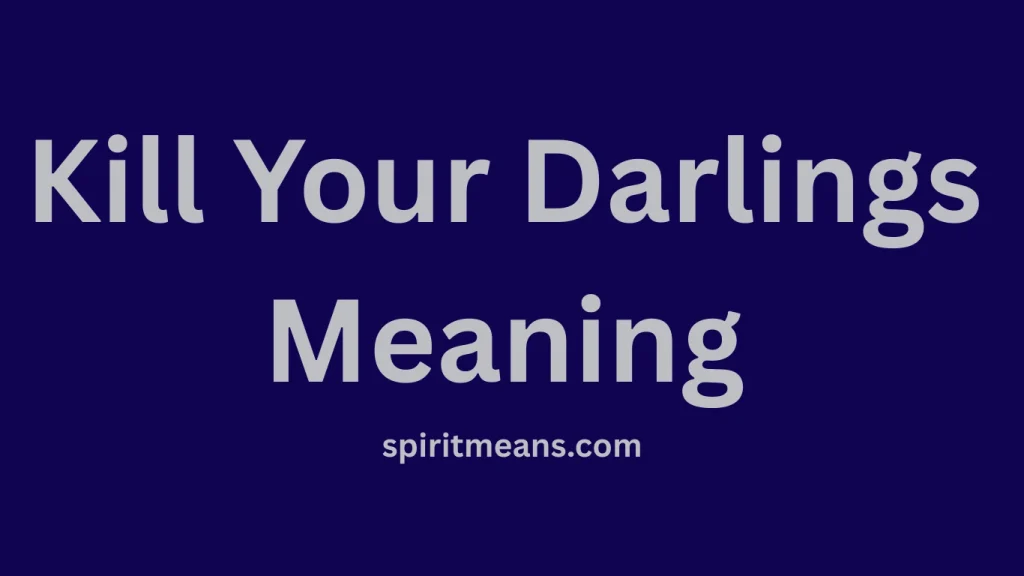Kill Your Darlings Meaning for Stronger Writing

Writing is not just about putting words together; it is about creating meaning and clarity for readers. When people hear the phrase kill your darlings meaning, it may sound harsh, but it carries important wisdom. Writers often fall in love with their own words, phrases, or ideas, but these favorite parts may not serve the overall piece. Learning to cut them is the secret to stronger writing.
Understanding the Concept
The kill your darlings meaning is simple: you must be ready to remove passages that you love but that do not help your work. This advice pushes writers to focus on the needs of the reader, not just their personal feelings. What you enjoy writing might not be what your audience needs to understand the message.
When editing, writers may struggle because their emotions are tied to the words. Yet, cutting unnecessary content allows the best parts of a story or essay to shine. It ensures that only the strongest, most relevant ideas stay in the text.
The Origins of the Phrase
The phrase dates back to early writing discussions, with credit often given to William Faulkner. He is remembered for saying, “In writing, you must kill all your darlings.” But other writers before him, like Arthur Quiller-Couch, also expressed similar ideas. No matter who first said it, the meaning remains the same: edit with courage.
The phrase has become popular in creative writing classes and professional editing. Today, it stands as a golden rule in all forms of communication, from novels to blog posts. Even business writers and journalists apply it to keep their work sharp and professional.
Why Writers Should Embrace It?
Writers may believe that every word they write is valuable. But the truth is that readers care more about clarity than beauty. If a sentence distracts, confuses, or slows down the message, it is better to cut it. The kill your darlings meaning teaches that good writing is not about saving every idea—it is about saving the best ones.
By removing weak sections, the strong ones can shine. This process is similar to a sculptor carving away excess stone to reveal a masterpiece underneath. The writing becomes lean, powerful, and direct.
How to Apply It in Practice?
Applying the principle is easier when you understand the process. Writers should take time after drafting to read their work with fresh eyes. Reading aloud often highlights awkward or unnecessary parts. When you stumble or lose focus, it usually signals a “darling” that should go.
Another method is peer review. Ask someone else to read your work and point out what feels unnecessary. They will not have the same emotional connection to your favorite sentences, making their judgment more objective. Remember, the kill your darlings meaning is about serving readers, not just yourself.
Common Examples of Darlings
Imagine writing a descriptive essay about a city street. You might spend a whole paragraph describing the colors of a single café. It sounds poetic, but if it does not add to the story, it slows the reader. Cutting that description makes the scene flow better.
In fiction, writers often fall in love with clever dialogue or metaphors. While these may sound impressive, they risk sounding forced or artificial. In non-fiction, a “darling” could be a personal story that does not directly connect to the main topic. Letting it go creates tighter writing that readers appreciate.
Table: When to Cut and When to Keep
| Situation | Keep or Cut | Why It Matters |
| Distracts from main point | Cut | Removes confusion and helps the main message stay strong |
| Adds humor that fits tone | Keep | Keeps readers engaged and lightens the mood |
| Overly detailed description | Cut | Readers lose focus when details add no new meaning |
| Creates emotional connection | Keep | Strengthens reader empathy and supports the story’s purpose |
| Sounds clever but unnecessary | Cut | Clever words without meaning hurt clarity |
This table shows how the phrase works in daily writing decisions. By checking your content against these rules, you can decide what stays and what goes.
Why It Is Hard to Kill Your Darlings?
Many writers resist the process because they feel deeply connected to their words. They may spend hours crafting a phrase, making it sound perfect. Removing it feels like wasted effort. But the kill your darlings meaning is not about wasting effort—it is about refining.
Think of it like exercise. Cutting words is painful at first, but it builds stronger writing habits. Over time, you learn not to cling to every phrase. Instead, you focus on the core idea. Readers thank you for respecting their time and giving them clarity.

Benefits of Following the Rule
The benefits of applying this rule reach beyond simple editing. Writers who embrace it develop sharper communication skills. They learn to respect the reader’s attention span. They also gain discipline, understanding that writing is not about personal pride but about delivering value.
Following this principle improves flow, readability, and audience trust. Readers sense when writing feels direct and focused. They stay engaged, which is the ultimate goal of any piece of content.
Connection to Modern Writing and SEO
In modern times, this rule even applies to online writing and SEO. Search engines like Google reward content that is clear, concise, and useful. Adding extra words or phrases that do not help the reader can harm performance. The kill your darlings meaning applies here too: cut fluff, focus on clarity.
Writers must balance creativity with search optimization. Using a keyword naturally, as we do here, supports SEO while keeping writing smooth. Too much repetition makes text clunky, while too little hurts rankings. The phrase teaches balance—keeping only what strengthens the message.
How Readers Benefit?
Readers may not know the phrase, but they benefit when it is applied. They enjoy articles that flow without distractions. They find value in text that is simple and direct. By removing unnecessary parts, writers make reading enjoyable.
This principle respects the reader’s time. It shows that the writer values clarity over personal pride. In the long run, this builds loyalty, because readers trust writers who communicate honestly.
Real-Life Applications Beyond Writing
Although the phrase comes from writing, its wisdom applies to life. People hold onto ideas, habits, or possessions that they love but that no longer serve them. Letting go of these “darlings” makes room for growth.
In business, cutting unproductive projects is a way to “kill your darlings.” In art, removing elements from a design often improves it. The principle is universal: remove what weakens the whole, even if you are attached to it.
Frequently Asked Questions
What is the kill your darlings meaning in simple words?
It means removing parts of your writing you love if they do not help the reader or the story.
Who first said the phrase?
William Faulkner often gets credit, but Arthur Quiller-Couch expressed a similar idea earlier in the 20th century.
Does it apply to all types of writing?
Yes, from novels to blog posts, essays, and business writing, it always helps to keep text clear and useful.
Is it okay to keep some darlings?
Yes, if they add real value. The goal is not to cut everything you love but to cut what distracts from meaning.
How do I know when to cut?
If a sentence distracts, slows the flow, or confuses the reader, it is time to remove it.
Conclusion
The kill your darlings meaning is more than a phrase; it is a mindset that guides better writing. Writers grow stronger when they stop clinging to words that do not serve the text. Each cut sharpens the message and respects the reader’s time.
This principle goes beyond editing—it teaches humility, discipline, and clarity. By embracing it, you create writing that speaks directly to your audience. The next time you finish a draft, ask yourself: is every word here for the reader, or is it just for me? If it is only for you, it may be time to let it go.
